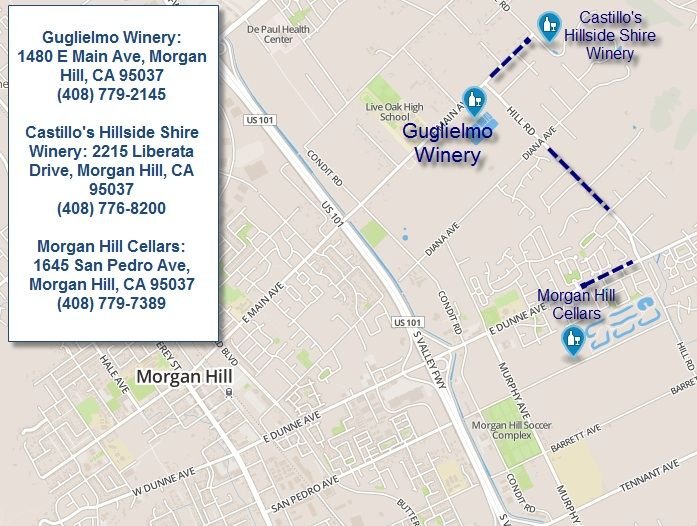It was a warm and unusually windy Sunday afternoon in Morgan Hill when I spoke with third-generation winemaker George E. Guglielmo. We sat at a picnic table outside the winery, catching napkins that kept taking flight and clutching our wine glasses for fear the wind would soon claim them.
It’s rare to find George sitting if you spot him at the winery. Constantly in motion, he seems to have a hand in every facet of his family’s wine business.
On this particular Sunday he’d just finished working the winery’s 45th Cork Equity—an event held at the winery four times a year, where guests line up to bottle their own red wine. The Cork Equity red is a blend that varies at every event, made up of several different varietals from Cabernet Sauvignon to Zinfandel and Petite Sirah. And at only $6 per bottle, it’s a great value.
Many may be familiar with Guglielmo Winery and its history in Morgan Hill. Emilio Guglielmo, winery founder, migrated to the United States in 1908 with a dream of one day owning a vineyard and in 1925 he purchased 15 acres of land in the Santa Clara Valley.
The winery now has sprawling vineyards planted across nearly 70 acres of land and this family-owned winery is the oldest operating winery in the area. It has been passed down through three generations and is now run by Emilio’s three grandsons—George E., Gene and Gary Guglielmo.
And it was George who took over the winemaking side of the business. While in high school, he wanted to learn as much as he could about growing grapes and winemaking so he apprenticed at wineries, including San Martin Winery, where he would test the wines chemistry. Once he graduated from high school, he decided to dedicate his life to the family business.
“It’s a changing, changing, changing industry,” George said. “Just the last 10 years have been monumental.”
Techniques have evolved tremendously in the last 10 to 20 years, but George also notes a big change in the late 1960s—the change to varietal wines.
Before 1969, the winery was known for making everyday table wine, with a jug of its Reserve Burgundy selling for about 70 cents. When George graduated from the Viticulture and Enology program at Fresno State University in 1969, the first premium varietal wine was bottled from the Guglielmo estate: the 1969 Petite Sirah.
The history of California winemaking in the late ’60s often shows a similar transition in wineries—one from bulk production (table wine blends) to another form of winemaking, which became premium production—making finer wines that focused on grape varietals like Chardonnay, Zinfandel and Cabernet Sauvignon.
Today, Guglielmo produces more than 40,000 cases of wine annually, bottling many varietals sold under three different labels: Private Reserve, Tré and the oldest label, Emile’s. But one thing hasn’t changed—many varietals have remained popular over time.
“The top seller for white wine is the Chardonnay and top red wine would probably be the Zinfandel,” George said. “It hasn’t really changed over the years.”
He did note one big change in consumer’s tastes in the ’80s. In 1986, the term French paradox was first shared in a newsletter, the International Organization of Vine and Wine. It was noted that although French people ate a diet high in saturated fats, their mortality rate from coronary heart disease was relatively low. The United States and United Kingdom, although consuming nearly equivalent amounts of saturated fats, had a much higher mortality rate from CHD. The theory was the French regularly consumed more red wine and the antioxidants in red wine—polyphenols—may help protect the lining of blood vessels in the heart.
“People in France ate more high cholesterol foods and drank more red wine,” George said. “When the French paradox came out, we saw more consumption of red wine with people suddenly shifting from white wines to reds. You just change and grow with the industry and with what the consumer wants.”
But consumer tastes aren’t the only changes in the past decade or two.
“Another major change over the past 15 years in Santa Clara Valley, as elsewhere in the state, is the explosion of small wineries,” said Larry Spivak, retired tasting room manager at Guglielmo (whom you will still find pouring wine on most weekends). “Correspondingly, the decline in the number of wine distributors has forced anyone outside of Napa and Sonoma to depend on retail sales at the winery in order to stay in business.”
According to the Wine Institute, in 1965 there were only 232 bonded wineries in California; now there are 3,754. (Federal law requires anyone conducting wine operations—outside of home consumption—obtain a bond.)
“With a substantial amount of wineries in the Valley, we are now a destination for millions of people in the San Francisco Bay area,” Spivak said. “The only real problem is a lack of land for more vineyards in Santa Clara Valley but there is plenty of land just south of here and in Monterey.”
When looking toward the future in Santa Clara Valley, the hope is that more local wines will be sold in restaurants and markets in this area.
“If you go to Italy or France and sit down at a restaurant, you’re going to drink local wines,” George said. “We’re not at that point in Santa Clara Valley.”
Chrissy Bryant is a writer, social media manager and former Morgan Hill native who loves staying active, enjoys California sunshine and a great glass of wine. This article is the first in a series to complete a master’s degree project at San Jose State University.













